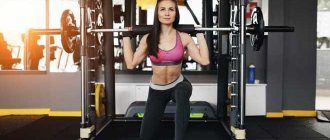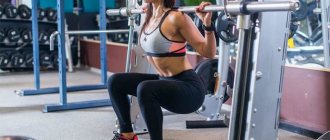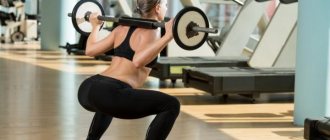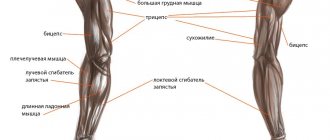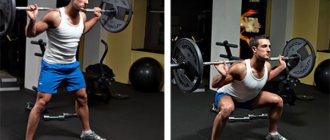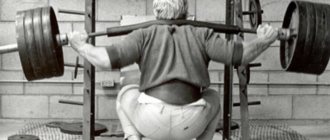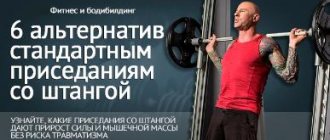The leg muscles are key to gaining muscle mass. Scientists have long proven that only basic leg exercises can stimulate the body to release the maximum amount of natural testosterone.
Basic exercises are considered to be various types of squats with a barbell or dumbbells, which involve more than two joints. And if a beginner needs only the usual classic squats with a barbell on his shoulders, then more advanced athletes think about the correct drawing of the muscles on their legs.
To pump up your quadriceps, you can use an exercise such as front squats. Few people do them because of the difficulty of performing them, since not everyone manages to hold the barbell and arms in the correct position. But for those who have mastered this art, pumping up the quadriceps is easier than others.
What barbell grips can I use?
There are two most common grips used when performing front squats.
The first one is the palms up grip. It allows you to firmly grasp the barbell and makes it possible to control its movement throughout the entire time of performing squats. But there is also a drawback - you need to have a certain flexibility, since this position of the hands, when the elbows and palms look up, cannot be comfortable for everyone.
The second grip is more universal and suitable for any person. With the barbell on your shoulder, cross your arms and touch them to the opposite shoulder. That is, the right hand should touch the left shoulder, and vice versa.
What is better: front squats or classic ones? What is the difference?
So, what is better, front squats or classic ones, let's find out right now.
- In the classic method, the bar is installed on the trapezoid, that is, behind the neck, and in the frontal method it is held on the chest;
- Classic squats are also done with a straight back, while the lower back is slightly bent, but the grip method is not important here - take it in a way that is comfortable for you;
- With frontal exercises, the weight will always be less than with classical exercises, because here you additionally need to maintain balance;
- Front squats versus classic squats are based mainly on this - they are safer for the lower back because they do not load the spine.
It is difficult to say which squats are better, because each of them has its own beneficial effect. We recommend including both in your training program - this way you are sure not to miss anything. Most importantly, soberly assess the level of your physical fitness, do not overload and carefully study the technique. At first, it may be worth hiring an experienced trainer.
Arch your back and squeeze your shoulder blades
Then step away from the racks and place your feet shoulder-width apart or slightly narrower. Other racks will force you to lean forward, which can affect the stability and position of the barbell.
The back should be absolutely flat, and the shoulder blades should be drawn inward. Front squats require special attention to posture. If you perform them with a round back, then the wrong muscles will be used that are supposed to work. Plus, the risk of injury increases.
When starting to squat, make sure that your elbows are above the bar, otherwise you will not be able to hold it and it will fall to the floor. Try to squat until parallel to the floor, and only then begin to rise up. Do 10-12 repetitions in this manner for 3-4 sets. Try to keep your knees open outward during the squat, otherwise the knee joint will be significantly loaded with the weight of the barbell.
Benefits of Exercise
Although squats with dumbbells are inferior to classic ones with a barbell. This does not mean that they are completely useless and this is evidenced by an impressive list of their advantages:
- Squats with dumbbells can be done at home. It is unlikely that anyone will keep a barbell at home, unless of course you have a specially designated place for this (for example, a basement or your yard). In all other cases, athletes prefer to use dumbbells at home, or perform EXERCISES WITH AN RESPANDER.
- This exercise will help beginning athletes practice their movements.
- The axial load (weight pressure from above) on the spine is reduced. Therefore, athletes with weak back muscles can squat with dumbbells. And those who had spinal injuries.
- Working with dumbbells is safer than working with a barbell. Since they can be thrown to the floor at any time. Without fear that they will crush you.
- Greater variability of exercises allows you to shift the emphasis from one muscle to another. Therefore, using just one dumbbell, you can fully develop your lower body.
- There is a comprehensive study of the muscles: arms, shoulders, back, legs and abdomen. Thanks to this, joints and ligaments are strengthened.
- When working with dumbbells, it is easier to squat to full amplitude. That is, at the lowest point, drop below parallel with the floor.
As you can see, the dumbbell squat has an impressive list of benefits. Therefore, this exercise can be safely adopted by both men and girls. As for beginners, for them this type of squats will generally be the best find.
What mistakes happen when athletes perform front squats with a barbell?
1. Shifting the center of gravity forward. There is no need to bend your body forward, as in classic squats. Considering that the bar is located in front of your body, this is not permissible.
2. Raised heels. Many people, when performing regular squats, prefer to slightly transfer everything onto their toes, raising their heels. When performing front squats, this should not be done, as this can lead to loss of balance and injury associated with the bar flying out and the athlete falling.
3. Crossed knees. Given the fairly close position of the legs in relation to each other, you need to carefully monitor the position of the knees. If, while performing, you see that your knees are approaching each other and bending inward, then stop doing the exercise immediately.
Do not put unreasonable stress on the knee joint
The knees should move in the same plane as the feet. In this case, they should look forward and not lean left or right. Improper execution threatens to cause the knee joint to fly out of the cup, which is quite difficult to treat, and the injury remains for the rest of one’s life, weakening the person’s musculoskeletal system.
Dropping your elbows down is also a mistake. When performing front squats, the elbow joint should always be pointing upward to prevent the bar from simply rolling down. This is the most common mistake that leads to incorrect execution of the exercise.
What muscle groups are involved?
Front squats are used to work the outer quadriceps muscles. Due to the fact that the weight is in front of the body, the gluteal muscles are loaded much worse than in classic squats. This fact helps to better focus on the outer lateral and front parts of the leg muscles.
Try to feel these muscles throughout the entire range of motion. You should not specifically connect and involve other muscle fibers in the work - this will only interfere and dissipate the load on the rest of the body.
What muscles work?
What muscles work when performing a front squat:
- In this exercise, the outer thigh (quadriceps) receives the lion's share of the load.
- Unlike classic squats, front squats place more stress on the lumbar region.
- The remaining part is distributed to the auxiliary muscles, the calf and gluteal muscles.
- Antagonist-stabilizing muscles also make their contribution, these include: the rectus abdominis and oblique muscles. Most athletes deliberately do not put additional stress on this area, citing the fact that in basic exercises (which is the front squat), the abdominal muscles receive their share of stress.
- But it’s not the muscles alone that bear all the brunt of the exercise. The hamstrings can also be classified as accessory.
© Makatserchyk — stock.adobe.com
Difficult choice
What is better to do – front squats or classic squats? The answer to this question will be correct for each specific case. If the goal is to load the front of the legs and draw muscle definition, then it is better to do front squats. If you are interested in voluminous muscle growth and development of the back of the thigh, as well as the buttocks, then you need to perform classic squats.
Remember: when doing front squats or regular squats, you must always follow safety precautions and perform the exercise correctly. Do a good warm-up of your leg muscles and joints, always wear a lifting belt, and find a partner to help you with your squats. It is best if your partner is a gym instructor who can always correct your technique and give some practical advice.
And in pursuit of developing your quadriceps, never chase the weights you lift. It's better to do more repetitions or artificially slow down the movements to put more stress on your legs. Unreasonably increasing the weight of the barbell will not do anything good, but will only provoke muscle strain or cause injury to the knee joint.
Types of squats with dumbbells
Let's look at several of the most effective types of squats with dumbbells.
Plie squats with dumbbells
Plie squats with dumbbells - to perform effectively, you need to hold it with both hands in front of you at waist level. Instead of a dumbbell, you can also use a kettlebell or a barbell disc. The main thing in this exercise is to maintain the correct body position.
- The dumbbell should not weigh you down or tilt you down.
- We place our feet wider than our shoulders, turn our toes outward, the angle is approximately 60 degrees.
- Keep your back strictly vertical.
It is advisable to place your feet on step platforms; this will increase the range of movement by a few precious centimeters, and you will be able to go lower. Due to this, the buttocks and hip adductors will work harder. You need to lower yourself down until you touch the back of your thigh to your calf muscles. The pace of the exercise is smooth; no sudden movements should be made. It is important to feel the stretching and contraction of the muscles at each point of the amplitude.
Bulgarian squats
The next popular leg exercise that can be performed with dumbbells is Bulgarian squats. To perform them you will need a horizontal bench. We place one foot on the bench with the toe down, and bring the other forward. The distance between the legs should not be too large; the front leg should be slightly bent at the knee. Squat down smoothly on your front leg. Anatomically, the movement is similar to lunges. The farther you place the front leg, the more the gluteal muscles work; the closer, the more the load is emphasized on the quadriceps. Beginner fitness enthusiasts are advised to adhere to a certain “golden mean”: put one leg forward so that the knee remains slightly bent, and there are still a few centimeters between the knee and the foot.
If you want to additionally “hook” the inner surface of the thigh, do not place your front leg straight, but slightly turn your toe outward. The exercise should be done with moderate weight; in no case should you round the thoracic spine when lowering down. The amplitude here may be somewhat shortened. Often athletes work in a static-dynamic mode, without going all the way down and without straightening the knee at the top point. This way, the necessary muscle group will be under constant tension, and even light dumbbells will be enough to create sufficient prerequisites for muscle growth.
Squats with dumbbells on shoulders
Squats with dumbbells on the shoulders almost completely imitate classic squats with a barbell. The load vector falls in exactly the same way. The only difference is that there is no need to statically tense almost all the muscles of the torso, as with heavy squats with a barbell. Just position the dumbbells so that you are comfortable without them weighing you down. Keep your back as straight as possible so as not to place stress on the spinal extensors.
© artinspiring — stock.adobe.com
Another option for holding dumbbells on your shoulders:
© dusanpetkovic1 — stock.adobe.com
Deep squats with dumbbells in hands
You can load the quadriceps in isolation by performing deep squats with dumbbells in your hands. The easiest way to do this is to use one dumbbell or kettlebell and hold it in front of you at chest level. The result will be an almost complete imitation of front squats with a barbell. This exercise is often called goblet squats.
Here it is advisable to use a relatively narrow parallel position of the legs. Place your feet slightly narrower than shoulder-width apart so that you can comfortably perform the exercise with a decent weight and you can fully focus on contracting your quadriceps. At the bottom point, you can take a short pause, completely extinguish the inertia and rise upward in an explosive manner. This training method develops explosive strength and speed of movement well. In the same style, you can perform squats with dumbbells in your hands, keeping your arms straight along your body. This exercise is good for developing neuromuscular communication and teaches you better control of the stabilizer muscles, which will be useful for you on record weights in barbell squats.
Single leg dumbbell squats
For experienced athletes, squats with dumbbells on one leg are also good. This exercise requires not only strength, but also tremendous coordination and balance. It should be performed at a slow pace and with light working weights. Of course, before this you need to learn how to consistently perform pistol squats without additional weight, or at least with the help of TRX loops or other support.
© Makatserchyk — stock.adobe.com
Overhead dumbbell squats
CrossFit athletes can take note of an exercise such as overhead squats with dumbbells. It is not much different from overhead squats with a barbell in terms of biomechanics, but psychologically it is much easier. These exercises are needed in order to increase your results in basic weightlifting movements: snatch, clean and jerk, clean and others. Here you can give yourself free rein and work with heavy weights, but remember that the correct technique for performing the exercise is above all.
© Arsenii — stock.adobe.com
Alternatively, you can perform this variation of the movement with two dumbbells:
Scissor squats with dumbbells
Dumbbell scissor squats are a variation of lunges. They are especially popular among girls. They are done in exactly the same way as Bulgarian squats, only without using a bench. To increase the range of movement, you can place one or two step platforms under your front leg. This way you can go down as low as possible and fully bend your front leg at the knee joint. This way the quadriceps will do more work than when performing movements at half the amplitude.
